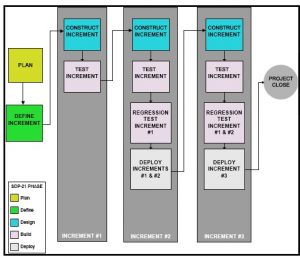Purpose:
Divide requirements into various builds, allowing multiple development cycles to take place.
Objective:
Cycles are divided up into smaller, more easily managed deliverables.
Description:
As its name implies, the Incremental Life Cycle Model supports the development of the system in increments. In the Incremental Model, the project begins with the Plan and Define, which concludes when all requirements, both technical and business, are identified and allocated to specific increments of the system.
The initial increment typically includes those software modules that address the core requirements and their functions. Subsequent increments introduce additional functions. Each increment then follows either the Traditional Waterfall Model or the Modified Waterfall Model for the Build, Test and, optionally, Deploy activities.
Note that not every increment need be deployed into the production environment upon completion. This increment model depicts this delayed deployment decision. Increment-1 does not get deployed until Increment-2 is ready for deployment. This could be based on the determination that the functions developed in Increment-1 need some of the functions in Increment-2 before there is a business value, and that Increment-1 has sufficient technical risk in it that the IT Team felt early development and testing of it was required.
Entrance Criteria:
Exit Criteria:
Process and Procedures:
- Planning
- Define
- Construct
- Testing
- Deploy
Tailoring Guidelines:
Process Verification Record(s):
Measure(s):
- <?>
- Maintained By: <?>
- Submitted By: <?>
- Frequency of Submission: <?>
References:
Say goodbye to your 40 webinars and 10 classroom sessions!
Enter the future of employee training with real-time, personalized guidance.
